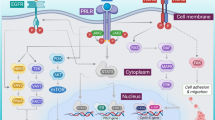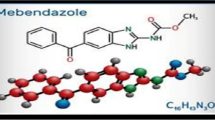Abstract
Doxorubicin (DOX) is widely used in cancer therapy of many carcinomas types. Unfortunately, DOX is not sufficiently effective in many cases, and increasing the dosage of it is limited due to its systemic toxicity. A citrus flavonoid hesperidin (HES) is proved to be potent antioxidant and protective agent against many diseases including cancer. In this context, the objective of this study was to examine effect of HES along with DOX on solid Ehrlich carcinoma (SEC) in mice. Forty male mice were divided into four equal groups (n = 10): control SEC, DOX, HES, and DOX + HES. HES (50 mg/kg body weight orally) was given day after day for 16 days along with DOX (4 mg/kg body weight i.p. injection) for 5 cycles every 4 days in ESC-inoculated mice. After 20 days, tumor volume, tumor weight, survival rate, tumor glutathione, nitric oxide content, and serum glutathione were determined. Tumor tissue was examined for histopathological and immunohistochemical study for p53 and VEGF. Tumor resistance for mdr1a gene was assessed in tumor tissue by RT-PCR. HES induced significant increase in tissue and serum glutathione with significant decrease in tumor volume and tumor weight. A possible role of HES to modulate gene expression of mdr1a in tumor tissue was established. In addition, HES alleviated the histopathological changes with significant decrease in p53 and VEGF expression. The use of HES as adjuvant therapy with DOX would enhance the therapeutic efficacy and alleviate the resistance to DOX in treatment of solid tumors.






Similar content being viewed by others
References
Agrawal SS, Saraswati S, Mathur R, Pandey M. Cytotoxic and antitumor effects of brucine on Ehrlich ascites tumor and human cancer cell line. Life Sci. 2011;89:147–58.
Alamed J, Chaiyasit W, McClements DJ, Decker EA. Relationships between free radical scavenging and antioxidant activity in foods. J Agric Food Chem. 2009;57(7):2969–76.
Arafa HM, Aly HA, Abd-Ellah MF, El-Refaey HM. Hesperidin attenuates benzo[alpha] pyrene-induced testicular toxicity in rats via regulation of oxidant/antioxidant balance. Toxicol Ind Health. 2009;25(6):417–27.
Bustin and Stephen A. (ed) A-Z of Quantitative PCR. La Jolla, CA: International University Line. 2004–2006.
Chatterjee K, Zhang J, Honbo N, Karliner JS. Doxorubicin cardiomyopathy. Cardiology. 2010;115(2):155–62.
Choi EJ, Kim GH. Anti-/pro-apoptotic effects of hesperetin against 7,12-dimetylbenz(a)anthracene-induced alteration in animals. Oncol Rep. 2011;25(2):545–50.
Corpet DE, Taché S. Ranking chemopreventive agents on rat colon carcinogenesis. IARC Sci Publ. 2002;156:381–4.
Dabkeviciene D, Sasnauskiene A, Leman E, Kvietkauskaite R, Kirveliene V. Differential expression of VEGF and IL-1alpha after photodynamic treatment in combination with doxorubicin or taxotere. Anticancer Res. 2014;34(10):5295–302.
Darvesh AS, Aggarwal BB, Bishayee A. Curcumin and liver cancer: a review. Curr Pharm Biotechnol. 2012;13(1):218–28.
Deavall DG, Martin EA, Horner JM, Roberts R. Drug-induced oxidative stress and toxicity. J Toxicol. 2012;645460–72.
El-Ashmawy N, Khalil R. A review on the role of L-carnitine in the management of tamoxifen side effects in treated women with breast cancer. Tumor Biol. 2014;35(4):2845–55.
Ellman GL. Tissue Sulfhydryl Groups. Arch Biochem Biophys. 1959;82:70–7.
Erbas H, Aydogdu N, Usta U, Erten O. Protective role of carnitine in breast cancer via decreasing arginase activity and increasing nitric oxide. Cell Biol Int. 2007;31:1414–9.
Firuzi O, Miri R, Tavakkoli M, Saso L. Antioxidant therapy: current status and future prospects. Curr Med Chem. 2011;18(25):3871–88.
Gammella E, Maccarinelli F, Buratti P, Recalcati S, Cairo G. The role of iron in anthracycline cardiotoxicity. Front Pharmacol. 2014;26:5–25.
Gao JZ, Wang YL, Li J. i LX. Effects of VEGF/VEGFR/K-ras signaling pathways on miRNA21 levels in hepatocellular carcinoma tissues in rats. Genet Mol Res. 2015;14(1):671–9.
Guan J, Chen J. Mesenchymal stem cells in the tumor microenvironment. Biomed Rep. 2013;1(4):517–21.
Hanahan D, Weinberg RA. Hallmarks of cancer: the next generation. Cell. 2011;144(5):646–74.
Hwang SL, Yen GC. Effect of hesperetin against oxidative stress via ER- and TrkA-mediated actions in PC12 cells. J Agric Food Chem. 2011;59(10):5779–85.
Jäeger W. Classical resistance mechanisms. Int J Clin Pharmacol Ther. 2009;47(1):46–8.
Jaganathan SK, Mondhe D, Wani ZA, Pal HC, Mandal M. Effect of honey and eugenol on Ehrlich ascites and solid carcinoma. J Biomed Biotechnol. 2010;989163–67.
Kamaraj S, Ramakrishnan G, Anandakumar P, Jagan S, Devaki T. Antioxidant and anticancer efficacy of hesperidin in benzo(a)pyrene induced lung carcinogenesis in mice. Invest New Drugs. 2009;27(3):214–22.
L’Ecuyer T, Sanjeev S, Thomas R, Novak R, Das L, Campbell W, et al. DNA damage is an early event in doxorubicin-induced cardiac myocyte death. Am J Physiol Heart Circ Physiol. 2006;291(3):H1273–80.
Li D, Li J, An Y, Yang Y, Zhang SQ. Doxorubicin-induced apoptosis in H9c2 cardiomyocytes by NF-κB dependent PUMA upregulation. Eur Rev Med Pharmacol Sci. 2013;17(17):2323–9.
Liu J, Zhang C, Feng Z. Tumor suppressor p53 and its gain-of-function mutants in cancer. Acta Biochim Biophys Sin (Shanghai). 2014;46(3):170–9.
Lowry OH, Rosenbrough NJ, Farr AL, Randall RJ. Protein measurement with the Folin- phenol reagent. J Biol Chem. 1951;193:265–75.
Maciag AE, Chakrapani H, Saavedra JE, Morris NL, Holland RJ, Kosak KM, et al. The nitric oxide prodrug JS-K is effective against non-small-cell lung cancer cells in vitro and in vivo: involvement of reactive oxygen species. J Pharmacol Exp Ther. 2011;336(2):313–20.
Manne U, Weiss HL, Myers RB, Danner OK. Nuclear accumulation of p53 in colorectal adenocarcinomas: prognostic importance differs with race and location of tumor. Cancer. 1998;83:2456–67.
Martinez L, Arnaud O, Henin E, Tao H, Chaptal V, Doshi R, et al. Understanding polyspecificity within the substrate-binding cavity of the human multidrug resistance P-glycoprotein. FEBS J. 2014;281(3):673–82.
Meiyanto E, Hermawan A, Anindyajati. Natural products for cancer-targeted therapy: citrus flavonoids as potent chemopreventive agents. Asian Pac J Cancer Prev. 2012;13(2):427–36.
Menendez D, Nguyen TA, Freudenberg JM, Mathew VJ, Anderson CW, Jothi R, et al. Diverse stresses dramatically alter genome-wide p53 binding and transactivation landscape in human cancer cells. Nucleic Acids Res. 2013;41(15):7286–301.
Miranda-Vilela AL, Portilho FA, de Araujo VG, Estevanato LL, Mezzomo BP, Santos Mde F, et al. The protective effects of nutritional antioxidant therapy on Ehrlich solid tumor bearing mice depend on the type of antioxidant therapy chosen: histology, genotoxicity and hematology evaluations. J Nutr Biochem. 2011;22(11):1091–8.
Mizutani T, Hattori A. New horizon of MDR1 (P-glycoprotein) study. Drug Metab Rev. 2005;37(3):489–510.
O’Connor R, Clynes M, Dowling P, O’Donovan N, O’Driscoll L. Drug resistance in cancer - searching for mechanisms, markers and therapeutic agents. Expert Opin Drug Metab Toxicol. 2007;3(6):805–17.
Oz E, Ilhan MN. Effects of melatonin in reducing the toxic effects of doxorubicin. Mol Cell Biochem. 2006;286(1–2):11–5.
Pari L, Karthikeyan A, Karthika P, Rathinam A. Protective effects of hesperidin on oxidative stress, dyslipidaemia and histological changes in iron-induced hepatic and renal toxicity in rats. Toxicol Rep. 2015;2:46–55.
Park HJ, Kim MJ, Ha E, Chung JH. Apoptotic effect of hesperidin through caspase3 activation in human colon cancer cells, SNU-C4. Phytomedecine. 2008;15(1–2):147–51.
Ridnour LA, Sim JE, Hayward MA, Wink DA, Martin SM, Buettner GR, et al. A spectrophotometric method for the direct detection and quantitation of nitric oxide, nitrite, and nitrate in cell culture media. Anal Biochem. 2000;281(2):223–9.
Ross JA, Kasum CM. Dietary flavonoids: bioavailability, metabolic effects, and safety. Annu Rev Nutr. 2002;22:19–34.
Sakata K, Hirose Y, Qiao Z, Tanaka T, Mori H. Inhibition of inducible isoforms of cyclooxygenase and nitric oxide synthase by flavonoid hesperidin in mouse macrophage cell line. Cancer Lett. 2003;199(2):139–45.
Zhang FY, Du GJ, Zhang L, Zhang CL, Lu WL, Liang W. Naringenin enhances the anti-tumor effect of doxorubicin through selectively inhibiting the activity of multidrug resistance-associated proteins but not P-glycoprotein. Pharm Res. 2009;26:914–25.
Author information
Authors and Affiliations
Corresponding author
Rights and permissions
About this article
Cite this article
Khedr, N.F., Khalil, R.M. Effect of hesperidin on mice bearing Ehrlich solid carcinoma maintained on doxorubicin. Tumor Biol. 36, 9267–9275 (2015). https://doi.org/10.1007/s13277-015-3655-0
Received:
Accepted:
Published:
Issue Date:
DOI: https://doi.org/10.1007/s13277-015-3655-0




